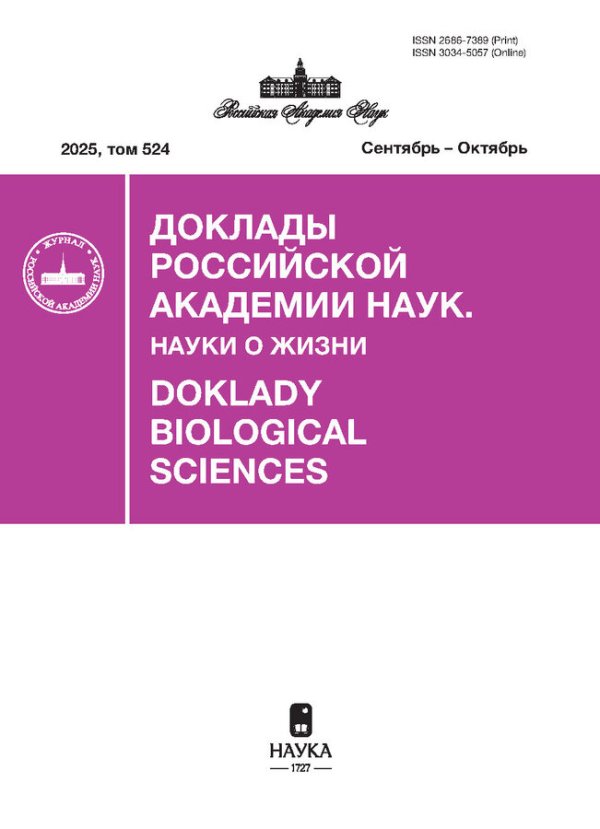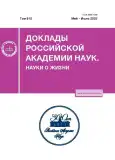ВЛИЯНИЕ УСЛОВИЙ КУЛЬТИВИРОВАНИЯ НЕЙРОСФЕР ГЛИОБЛАСТОМЫ НА ЭКСПРЕССИЮ ГЕНОВ ДЛИННЫХ НЕКОДИРУЮЩИХ РНК MALAT1 И lincROR
- Авторы: Мазур Д.В.1, Мишанова А.В.1, Коваленко Т.Ф.1, Шахпаронов М.И.1, Антипова Н.В.1,2
-
Учреждения:
- Институт биоорганической химии им. академиков М.М. Шемякина и Ю.А. Овчинникова Российской академии наук
- Факультет биологии и биотехнологии, Высшая школа экономики
- Выпуск: Том 510, № 1 (2023)
- Страницы: 243-246
- Раздел: Статьи
- URL: https://journals.rcsi.science/2686-7389/article/view/135690
- DOI: https://doi.org/10.31857/S2686738922600960
- EDN: https://elibrary.ru/QFAHLS
- ID: 135690
Цитировать
Полный текст
Аннотация
Мультиформная глиобластома (МГБ) является наиболее агрессивной злокачественной опухолью головного мозга. Одной из причин устойчивости МГБ к лечению является чрезвычайная гетерогенность опухоли и, в частности, присутствие в общей популяции клеток глиобластомы опухолевых стволовых клеток (ОСК). В данной работе мы исследовали влияние условий, уменьшающих долю ОСК в популяции клеток МГБ, на уровни длинных некодирующих РНК (lincROR и MALAT1), участвующих в формировании фенотипа раковых стволовых клеток глиобластомы. Мы показали, что культивирование в условиях, вызывающих уменьшение стволовости клеток (при добавлении в культуральную среду эмбриональной телячьей сыворотки) влияло на содержание этих транскриптов: в клетках большинства анализируемых линий отмечались снижение уровня позитивного регулятора стволовости lincROR и повышение содержания MALAT1.
Ключевые слова
Об авторах
Д. В. Мазур
Институт биоорганической химииим. академиков М.М. Шемякина и Ю.А. Овчинникова Российской академии наук
Email: nadine.antipova@gmail.com
Россия, Москва
А. В. Мишанова
Институт биоорганической химииим. академиков М.М. Шемякина и Ю.А. Овчинникова Российской академии наук
Email: nadine.antipova@gmail.com
Россия, Москва
Т. Ф. Коваленко
Институт биоорганической химииим. академиков М.М. Шемякина и Ю.А. Овчинникова Российской академии наук
Email: nadine.antipova@gmail.com
Россия, Москва
М. И. Шахпаронов
Институт биоорганической химииим. академиков М.М. Шемякина и Ю.А. Овчинникова Российской академии наук
Email: nadine.antipova@gmail.com
Россия, Москва
Н. В. Антипова
Институт биоорганической химииим. академиков М.М. Шемякина и Ю.А. Овчинникова Российской академии наук; Факультет биологии и биотехнологии,
Высшая школа экономики
Автор, ответственный за переписку.
Email: nadine.antipova@gmail.com
Россия, Москва; Россия, Москва
Список литературы
- Louis D.N., Perry A., Wesseling P. et al. // The 2021 WHO Classification of Tumors of the Central Nervous System: a summary. Neuro Oncol. 2021. V. 23. P. 1231–1251.
- Simon J.M., Toubiana T., Lang P. et al. // Radiotherapy for glioblastomas: from radiobiology to concomitant chemotherapy. Cancer Radiother. 2005. V. 9. P. 322–331.
- Bradshaw A., Wickremsekera A., Tan S.T. et al. // Cancer Stem Cell Hierarchy in Glioblastoma Multiforme. Front. Surg. 2016. V. 3. P. 21.
- Rao M.R.S. // Long non-coding RNA biology. Singapore: Springer Nature. 2017. 323 p.
- Loewer S., Cabili M.N., Guttman M., et al. // Large intergenic non-coding RNA-RoR modulates reprogramming of human induced pluripotent stem cells. Nat. Genet. 2010. V. 42. P. 1113–1117.
- Chen W., Yang J., Fang H. et al. // Relevance Function of Linc-ROR in the Pathogenesis of Cancer. Front. Cell. Dev. Biol. 2020. V. 8. P. 696.
- Kovalenko T.F., Yadav B., Anufrieva K.S. et al. // Functions of long non-coding RNA ROR in patient-derived glioblastoma cells. Biochimie. 2022. V. 200. P. 131–139.
- Li Z. // CD133: a stem cell biomarker and beyond. Exp. Hematol. Oncol. 2013. V. 2. P. 17.
- Ma R., Zhang B.W., Zhang Z.B. et al. // LncRNA MALAT1 knockdown inhibits cell migration and invasion by suppressing autophagy through miR-384/GOLM1 axis in glioma. Eur. Rev. Med. Pharmacol. Sci. 2020. V. 24. P. 2601–2615.
- Latorre E., Carelli S., Raimondi I. et al. // The Ribonucleic Complex HuR-MALAT1 Represses CD133 Expression and Suppresses Epithelial-Mesenchymal Transition in Breast Cancer. Cancer Res. 2016. V. 76. P. 2626–2636.
- Larionova T.D., Bastola S., Aksinina T.E. et al. // Alternative RNA splicing modulates ribosomal composition and determines the spatial phenotype of glioblastoma cells // Nat Cell Biol. 2022. V. 24. P. 1541–1557.
- Lee J., Kotliarova S., Kotliarov Y. et al. // Tumor stem cells derived from glioblastomas cultured in bFGF and EGF more closely mirror the phenotype and genotype of primary tumors than do serum-cultured cell lines. Cancer Cell. 2006. P. 391–403.
- Brewer G.J., Torricelli J.R., Evege E.K. et al. // Optimized survival of hippocampal neurons in B27-supplemented neurobasal, a new serum-free medium combination. Journal of Neuroscience Research. 1993. P. 567–576.
- Minata M., Audia A., Shi J. et al. // Phenotypic Plasticity of Invasive Edge Glioma Stem-like Cells in Response to Ionizing Radiation. Cell Rep. 2019. V. 26. P. 1893–1905.
- Freedman L.P., Gibson M.C., Ethier S.P. et al. // Reproducibility: changing the policies and culture of cell line authentication. Nat Methods. 2015. V. 12. P. 493–497.
Дополнительные файлы












